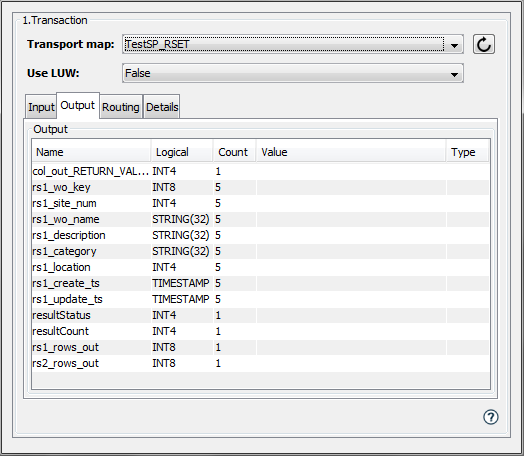A database transport map can be defined to invoke a
stored procedure with IN, OUT, and INOUT parameters and
also process data from multiple result sets.
When the stored procedure invocation is complete, the data
from the OUT or INOUT parameters can be written to output
variables.
If the stored procedure returns result sets, this data can
also be written to output variables.
Exceptions
A RDM transport does not support stored procedures. The Actions pick list will not show 'Stored Procedure' as a selection item for this database transport type.
Processing result set data from a stored procedure is allowed for the following database transport types:
- MSSQL
- Oracle (supported as an OUT parameter of type "REF CURSOR")
- DB2
- mySQL
Assumptions
You are familiar with configuring and invoking a stored procedure in the database server.
Defining the Stored Procedure transport map
- Using the Enterprise -> Transport Map tab,
select New to define a new transport
map.
- Select a previously defined database transport in
the Transport Name parameter.
- When the metadata is returned from the gateway, and
the Workbench populates the Schema
parameter, select the database schema you want to
use.
- In the Action parameter, select
Stored Procedure.
- In the Procedure parameter, select
the stored procedure you want to invoke.
For example: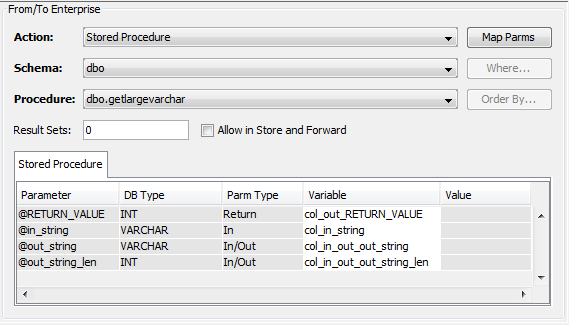
- The Workbench queries the stored procedure metadata
from the database and populates
the StoredProcedure
tab with parameter information.
- The From/To Enterprise title
indicates the direction of the data flows both ways
(bidirectional). In the case of a stored procedure, the
transaction would start with data flowing to the stored
procedure and would finish with data coming from the
stored procedure.
- The Allow in Store and Forward
check box is used to specify whether to invoke the
stored procedure when the transport is in the 'Store
and Forward' state. If the box is unchecked a transport
map with a stored procedure with INOUT or OUT
parameters will not be added to the Store and Forward
queue. This is because at some future point in time,
when the transport is able to connect to the database
server and execute the stored procedure, it will not be
able to deliver data from the INOUT and OUT parameters
of the stored procedure to a trigger action. Selecting
the Allow in Store and Forward
checkbox allows the transport map to be written to a
Store and Forward queue with the understanding that
when the procedure is eventually executed, the data
sent back to the map in the INOUT and OUT parameters
will be dropped (not processed).
- The Output tab becomes available
when a stored procedure with OUT or INOUT parameters is
specified.

- The Input tab will consist of a
map variables whose values are mapped to IN or INOUT
parameters of the stored procedure. The
Output tab will consist of map
variables that are the destination of data returned
from the OUT or INOUT parameters of the stored
procedure.
- To map a value to an IN or INOUT parameter, create
a map variable using the Input
tab.
- If the stored procedure is to return a value to an
OUT parameter, create the map variable using the
Output tab.
- When adding a map variable that will be used as an
INOUT parameter by the stored
procedure, you must create the variable on both the
Input and Output tab.
The variable names must exactly match; otherwise, the
StoredProcedure tab
will not recognize the variable as an INOUT
parameter.
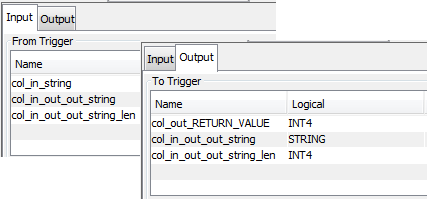
- Now associate the map variables with the stored
procedure parameters. If you need help with this task,
go to Associating
map variables with table columns.
- You can have the workbench automatically create map variables and associate them with stored procedure parameters by selecting the Map Parms button. If the variable is mapped to an INOUT parameter, it will be added to both the Input and Output tabs.
Configuring result sets
The Result Sets parameter is optional. It is used to specify the number of result sets the stored procedure is expected to return.
- If the Result Sets parameter is left blank, it indicates that you do not want to process result set information that may be returned from the stored procedure.
- If the Result Sets parameter is
set to a value, the Workbench will create a set of tabs
that corresponds to the number entered as shown in the
example below.
- These tabs can be used to specify column metadata information for the result set.
- The order of the tabs represents the order
in which the map is expecting the result sets
to be returned by the stored procedure.

If you are working with an Oracle stored procedure that
returns result sets, each result set is returned as an OUT
parameter of type REF CURSOR.
This is indicated by the Result Sets
parameter that is not editable. It will be populated with
the number of OUT parameters that contain result set
information.
The following example shows a transport map configured
to invoke an Oracle stored procedure.
Note the Result Sets parameter is not
editable and the DB Type column of the
procedure parameters that return a result set is "REF
CURSOR".
The number of result set tabs corresponds to the number of
"REF CURSOR" parameters.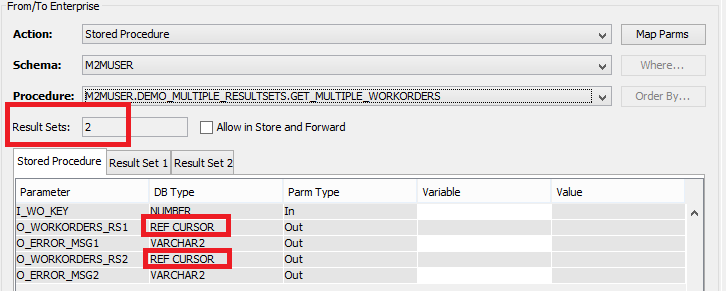
Specifying Result Set tab metadata
Navigate to a Result Set tab to specify metadata information about the result set.
- The Max Rows parameter is used to specify the maximum number of rows that will be processed from this result set.
- The Name parameter can be used to
specify a prefix for output variables that are created
to map content from this result set. It is populated
with a default value.
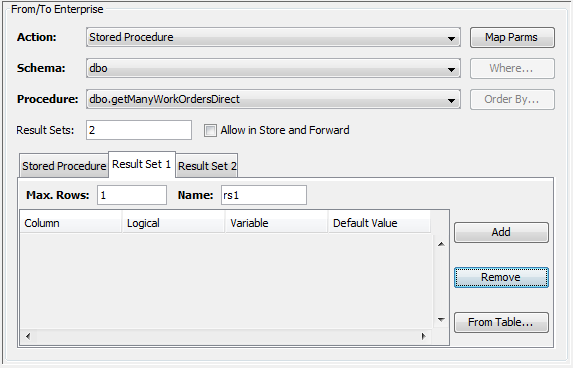
You can specify stored procedure metadata information by adding individual column information or by using the table lookup helper which is accessed by selecting the From Table... button.
Specifying result set column data individually
Select the Add button and a row will be
added to the Result Set tab as shown in the example
below: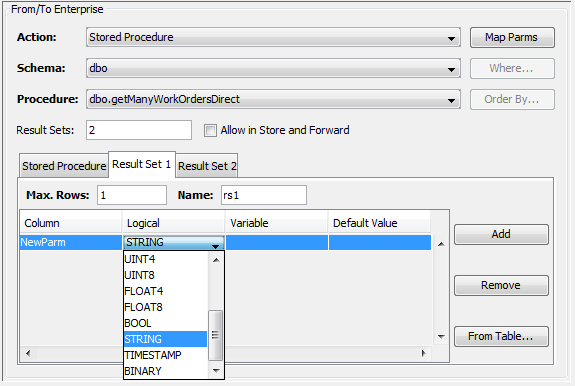
Each row in the Result Set tab has the following
columns:
| Parameter | Description |
|---|---|
| Column | The column name of the result set item that will be mapped. |
| Logical | The output variable data type that the column data will be converted to. |
| Variable | The output variable name that this result set column will be mapped to. |
| Default Value | A default value to be used when the column data is NULL. |
You can use the Remove button to remove a row from the Result Set tab.
Specifying result set column data based on a database table
Select the From Table... button to specify a table for the result set metadata.
A table selection panel is displayed, as shown in the example below.
Select the Schema and the Table.
The column information will be populated from the table.
- The columns show the name of the result set column (Name), the database datatype (DB Type) and the logical output variable datatype (Logical).
- You can multi-select the rows you want to add to the Result Set tab, and then select the Add Selected button.
- If you want to add all columns to the Result Set
tab, select the Add All button.
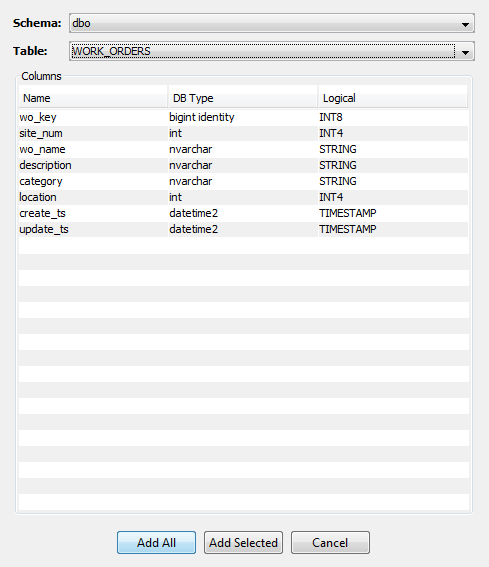
After selecting Add All or Add Selected, the popup panel is dismissed and the Result Set tab will be populated with table metadata as shown in the example below.
You can modify the contents of the panel by adding
additional rows or removing existing ones. You can also
edit the Column name or the
Logical data type if needed.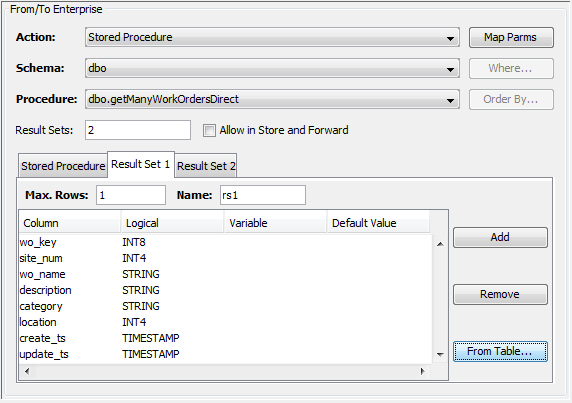
This process can be used to specify result set metadata for
each of the tabs.
Mapping input and output variables
Select the Map Parms button to have the workbench automatically create stored procedure and result set input and output variable data.
- The Input tab will contain variables for all IN and INOUT parameters.
- The Output tab will contain variables for INOUT and
result set tab data. All variables that get mapped from
result set data will have a result set name
prefix.
For example the output variable created for the 'site_num' result set parameter will be called 'rs1_site_num'.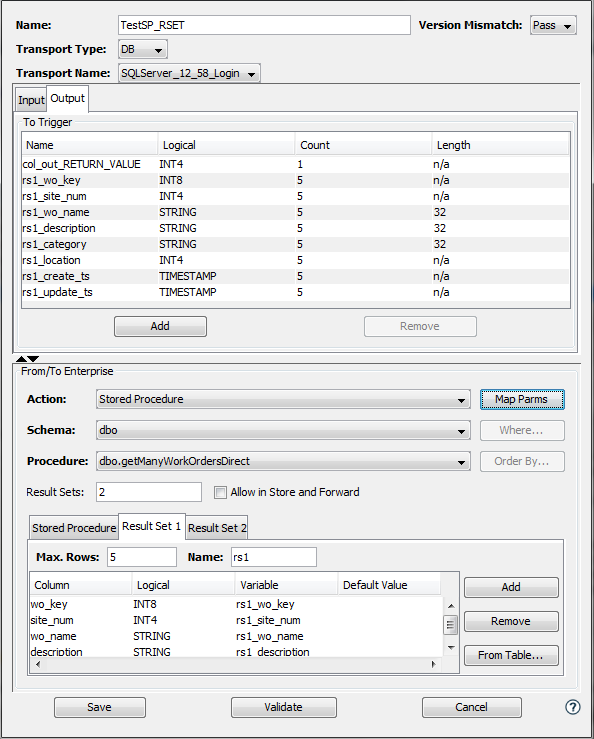
When you define a trigger that uses a Transaction action that references this Stored Procedure transport map, you associate the transport map's Output tab variables variables with the trigger's Transaction action Output tab.
Validating and saving the transport map
- Select Validate.
A window appears and displays a representation of the SQL statement that will be invoked when the transport map is processed.
- To close the window,
select OK.
- Select Save to save the transport map definition.
Using the Store Procedure in a trigger's Transaction action
The Stored Procedure transport map can be referenced in a trigger's Transaction action. The Input and Output tabs of the Transaction action will display input and output variables that were configured in the Stored Procedure transport map.
If the Stored Procedure transport map is configured to
process result sets you will see output variables that
represent the number of rows that are returned in each
result set.
In the example below the output variables 'rs1_rows_out'
and 'rs2_rows_out' will contain the number of rows
returned by each result set after the action executes
successfully.